Difference between revisions of "Disease resistance to fungal diseases"
(→Background on Resistance (R) genes and avirulence (Avr) genes) |
(→Gene-to-Gene Resistance) |
||
| (14 intermediate revisions by the same user not shown) | |||
| Line 22: | Line 22: | ||
== 3 Common Blueberry Fruit Rots == | == 3 Common Blueberry Fruit Rots == | ||
| − | [ohioline.osu.edu/hyg-fact/3000/pdf/3213.pdf OSU | + | [ohioline.osu.edu/hyg-fact/3000/pdf/3213.pdf OSU] |
# Alternaria - postharvest rot; most common | # Alternaria - postharvest rot; most common | ||
| Line 35: | Line 35: | ||
Caused by [http://www.plosgenetics.org/article/info:doi/10.1371/journal.pgen.1002230 ''Botrytis cinerea''] (genomic analysis of ''Botrytis'', a necrotrophic fungus) | Caused by [http://www.plosgenetics.org/article/info:doi/10.1371/journal.pgen.1002230 ''Botrytis cinerea''] (genomic analysis of ''Botrytis'', a necrotrophic fungus) | ||
| − | |||
== General Information & Genes == | == General Information & Genes == | ||
| Line 67: | Line 66: | ||
<center>[[File:Alternaria_resistance_in_Arabidopsis.pdf]]</center> | <center>[[File:Alternaria_resistance_in_Arabidopsis.pdf]]</center> | ||
| − | [http:// | + | [http://jxb.oxfordjournals.org/content/64/2/637.short '''Jia et al. 2013'''] discusses the role of 3 plant hormones (ethlynene [ET], jasmonic acid [JA], and salicylic acid [SA]) in necrotrophic fungal infections (such as ''Alternaria alternata'') in the tomato. They ultimately suggest the following pathway: |
<center>[[File:Alternaria_defense_in_tomatoes.pdf]]</center> | <center>[[File:Alternaria_defense_in_tomatoes.pdf]]</center> | ||
| Line 81: | Line 80: | ||
<center>[[File:Blueberry_Colletotrichum_ESTs.pdf]]</center>> | <center>[[File:Blueberry_Colletotrichum_ESTs.pdf]]</center>> | ||
| + | |||
| + | == Gene-to-Gene Resistance == | ||
| + | |||
| + | [http://www.sciencedirect.com/science/article/pii/S1369526600001771 Glazebrook 2001] | ||
| + | |||
| + | <center>[[File:Glazebrook_2001_gene-for-gene_resistance.pdf]]</center> | ||
| + | |||
| + | <center>[[File:Glazebrook_2001_gene-for-gene_resistance.pdf]]</center> | ||
| + | |||
| + | "Mutations in PBS1, NDR1, EDS1, PAD4, and PBS2 block gene-for-gene resistance that is mediated by some R genes." | ||
| + | 3 different signal transduction cascades acting downstream of R genes: 1) NDR-1 (and PBS-2) dependent, 2) EDS1 (and PAD4) dependent, 3) not sure of dependence | ||
| + | |||
| + | [http://www.annualreviews.org/doi/abs/10.1146/annurev.phyto.43.040204.135923 Glazebrook 2005] | ||
| + | |||
| + | "According to the model, gene-for-gene resistance should not be observed in in- teractions with necrotrophs, as host cell death is not predicted to limit pathogen growth. Furthermore, SA-dependent responses and SAR are not predicted to play a role, whereas responses mediated by JA and ET are expected to play a role." | ||
| + | |||
| + | -includes interesting take on biotrophic vs. necrotrophic fungi on ''Arabidopsis'' that contradicts what the plant guy said about SAR/ISR pathways | ||
| + | |||
| + | [http://www.google.com/patents?hl=en&lr=&vid=USPATAPP9887272&id=h9yXAAAAEBAJ&oi=fnd&dq=nbs-lrr+genes+blueberry+fungus+resistance&printsec=abstract#v=onepage&q&f=false Patent on "Plant Genes Involved in Defense Against Pathogens"] | ||
| + | |||
| + | -explanation of R gene signal transduction, SA-dependent signaling, JA-dependent signaling, and induced systemic resistance (ISR) | ||
| + | -particularly, explains the signal transduction pathways for EDS1 and NDR1 | ||
| + | |||
| + | [http://link.springer.com/article/10.1007%2Fs002399910023?LI=true#page-1 Plant NBS-LRR Resistance Gene Homologues] | ||
| + | |||
| + | -Fig. 1 lists some NBS-LRR genes important in plant resistance | ||
| + | |||
| + | <center>[[File:NBS-LRR_genes.png]]</center> | ||
| + | |||
| + | [http://www.ncbi.nlm.nih.gov/pmc/articles/PMC1973153/ DeYoung & Innes 2006] | ||
| + | |||
| + | -explanation of Plant NBS-LRR proteins | ||
== Things to Look Up == | == Things to Look Up == | ||
| − | + | [http://www.plantcell.org/content/16/12/3460.full.pdf+html Abscisic acid (AB) interactions with JA and ET pathways] | |
KEGG Pathway - environmental information processing - signal transduction - plant hormone transduction (look at dormancy) | KEGG Pathway - environmental information processing - signal transduction - plant hormone transduction (look at dormancy) | ||
[http://onlinelibrary.wiley.com/doi/10.1111/j.1399-3054.2006.00798.x/full Differential expression of strawberry genes as a result of ''Colletotrichum'' expression] | [http://onlinelibrary.wiley.com/doi/10.1111/j.1399-3054.2006.00798.x/full Differential expression of strawberry genes as a result of ''Colletotrichum'' expression] | ||
Latest revision as of 23:39, 15 April 2013
Media:Potential_Genes_of_Interest.xlsx
Contents
Background on Resistance (R) genes and avirulence (Avr) genes
R genes are found in the plant, while corresponding Avr gene is in the pathogen
Presumed roles of R genes:
- help plants detect pathogenic Avr gene products
- initiate signal transduction pathways that will help defend against the pathogen
- "have the capacity to evolve new R gene specificities rapidly"
If the R gene or corresponding pathogenic Avr gene are not present or altered, then plant is infected with the disease
The R protein recognizes the Avr gene product (ligand), activating a signal transduction cascade that initiates the defense against the pathogen. Thus, the R gene is turned on in healthy plants. R proteins must be able to evolve quickly in order to target new pathogens specifically. The evolution of the Avr genes directly impacts the evolution of the related R gene (coevolution).
"The majority of characterized plant R proteins resemble modular structures of the LRR-containing Toll-like receptors mediating animal innate immunity or the more recently discovered intracellular nucleotide-binding domain-LRR (Nod) proteins that are also implicated in PAMP perception in humans (Fig. 1) [4,13]. It is therefore reasonable to speculate that R-protein-mediated recognition in plants shares mechanistic features of non-self discrimination processes in animal cells."
3 Common Blueberry Fruit Rots
[ohioline.osu.edu/hyg-fact/3000/pdf/3213.pdf OSU]
- Alternaria - postharvest rot; most common
Caused by Alternaria tenuissima
- Anthracnose - serious pre- and postharvest disease
Caused by Colletotrichum acutatum (Yoshida et al. 2007)
- Botrytis - normally minor, but can be severe
Caused by Botrytis cinerea (genomic analysis of Botrytis, a necrotrophic fungus)
General Information & Genes
Parker 2003
-"innate immunity" through general elicitors (basically, molecules that are not specific to a certain cultivar)
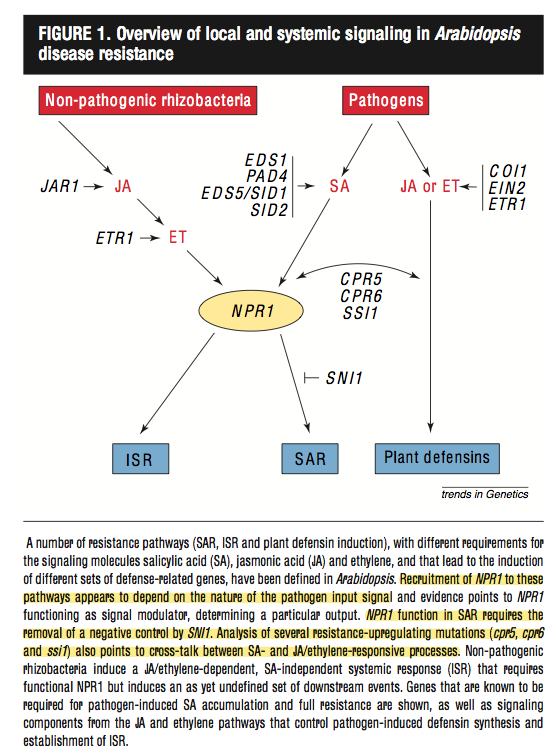
Explanation of Chitin Signaling and Fungal Invasion Response
-plants can recognize “surface-derived molecules” that elicit a general immune response (this is in addition to R gene-mediated pathways)
–pathogen-associated or microbe-associated molecular patterns (PAMPs/MAMPs)
-PAMPs are important for microbial invasion of a host cell
-glucans, chitins, and proteins derived from fungal cell walls serve as elictors, or “pathogen derived molecules” (Montesano et al 2003)
-during fungal infection, chitinases in the infected cell degrade the chitin on the cell wall of the invading fungus
-the remaining chitin fragments (chitooligosaccarides) then also serve as elicitors that provoke necessary “defense response genes”
-LysM RLKs (LsyM domain-containing receptor-like kinases): relatively large plant-specific protein family that researchers may suggest play a significant role in detecting fungal chitin
Ceasar & Ignacimuthu 2012 identified genes (mainly chitinases and glucanases) used into genetic engineering of crop plants. The tables below list important list the genes transformed and their source organism.
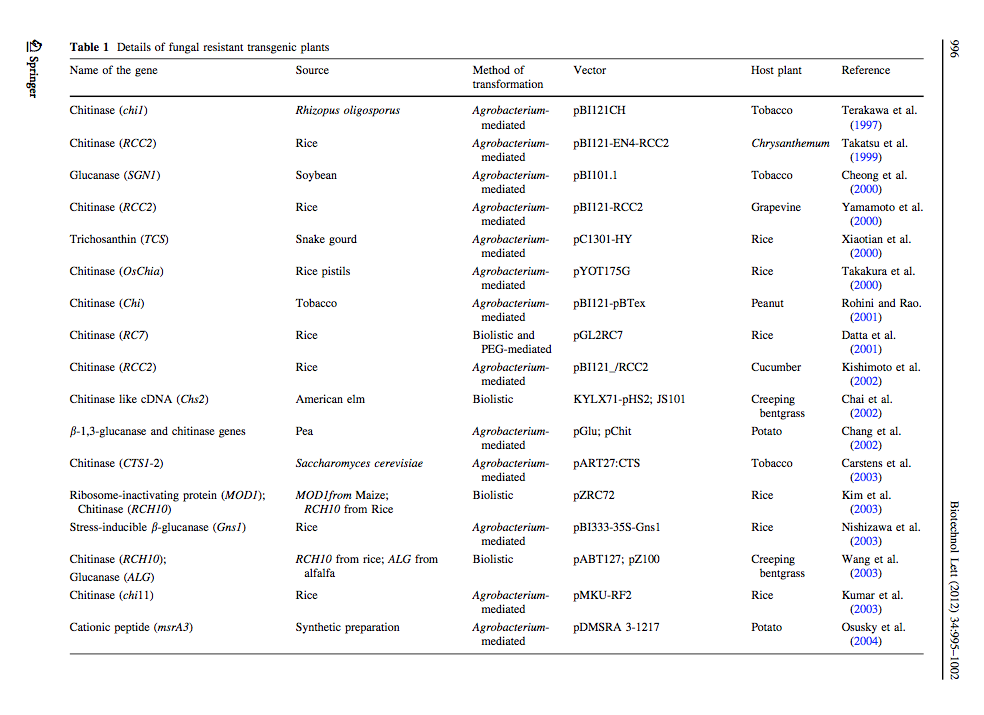
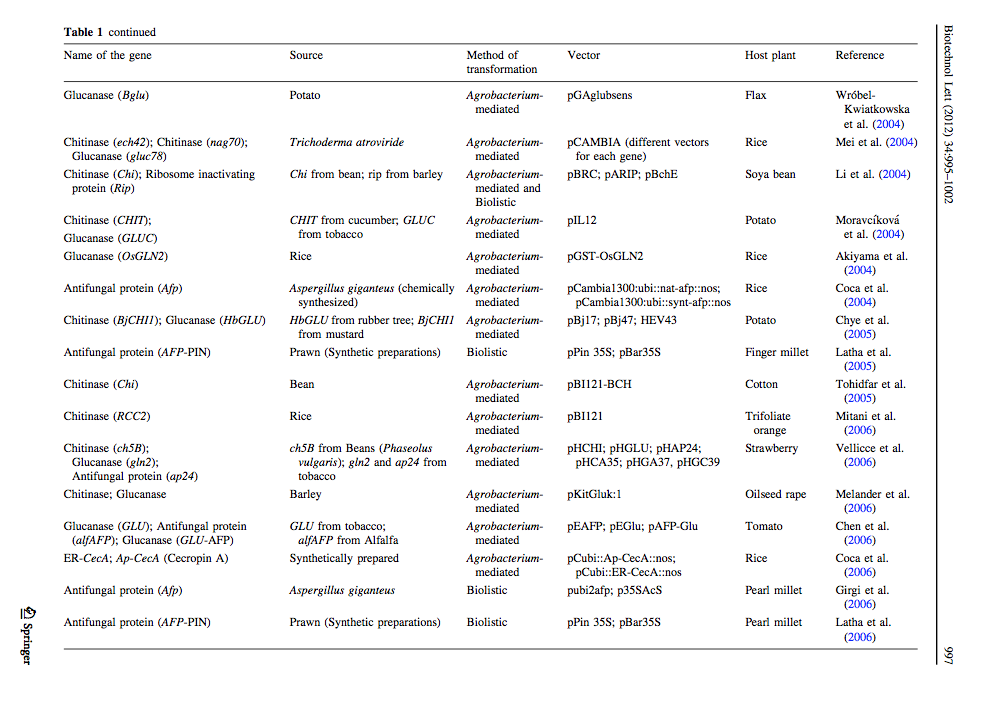
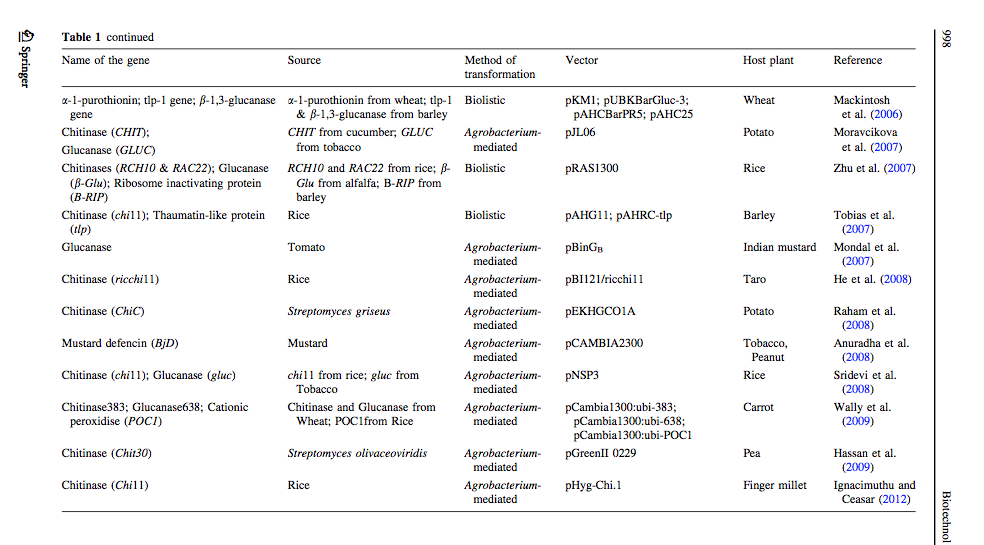
Alternaria
Feys & Parker 2000 outlined the signalling cascade for Alternaria in Arabidopsis:
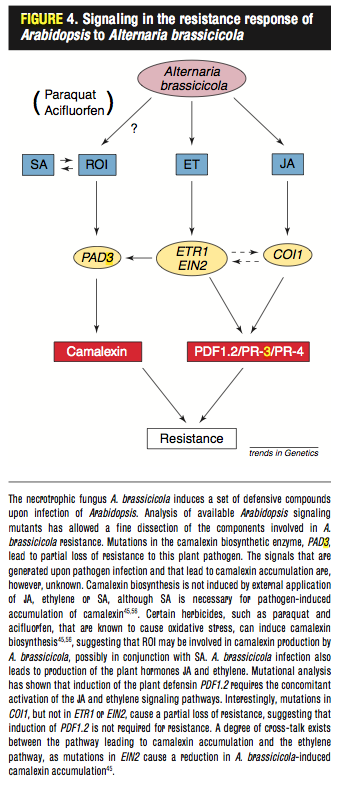
Jia et al. 2013 discusses the role of 3 plant hormones (ethlynene [ET], jasmonic acid [JA], and salicylic acid [SA]) in necrotrophic fungal infections (such as Alternaria alternata) in the tomato. They ultimately suggest the following pathway:

Thomma et al 1998 elucidated some of the genes in the JA and SA pathways in Arabidopsis. PR-1, PR-2 (a B-1,3-glucanase), and PR-5 follow an SA-dependent pathway.
PDF1.2 (a common plant defensin), PR-3 (a chitinase), and PR-4 (a hevein-like protein) depend on the JA pathway
Colletotrichum
Miles et al. 2011 identified ESTs in a Colletotrichum-resistant blueberry strains that were highly homologous to known defense genes, including a class II chitinase, pathogenesis-related protein 10 (PR10), and β-1,3-glucanase. They also found ESTs, such as monodehydroascorbate reduc- tase (EST03) and a metallothionein-like protein (EST05), associated with oxidative stress, which helps protect the plant from oxidative damage.
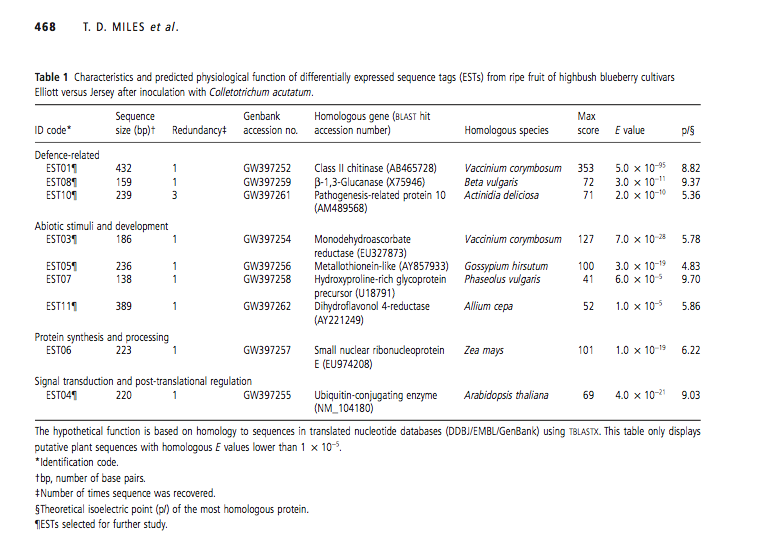
Gene-to-Gene Resistance
"Mutations in PBS1, NDR1, EDS1, PAD4, and PBS2 block gene-for-gene resistance that is mediated by some R genes." 3 different signal transduction cascades acting downstream of R genes: 1) NDR-1 (and PBS-2) dependent, 2) EDS1 (and PAD4) dependent, 3) not sure of dependence
"According to the model, gene-for-gene resistance should not be observed in in- teractions with necrotrophs, as host cell death is not predicted to limit pathogen growth. Furthermore, SA-dependent responses and SAR are not predicted to play a role, whereas responses mediated by JA and ET are expected to play a role."
-includes interesting take on biotrophic vs. necrotrophic fungi on Arabidopsis that contradicts what the plant guy said about SAR/ISR pathways
Patent on "Plant Genes Involved in Defense Against Pathogens"
-explanation of R gene signal transduction, SA-dependent signaling, JA-dependent signaling, and induced systemic resistance (ISR) -particularly, explains the signal transduction pathways for EDS1 and NDR1
Plant NBS-LRR Resistance Gene Homologues
-Fig. 1 lists some NBS-LRR genes important in plant resistance
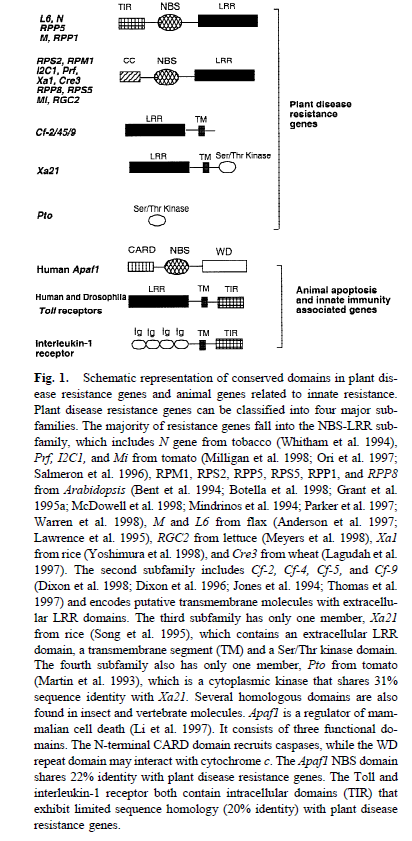
-explanation of Plant NBS-LRR proteins
Things to Look Up
Abscisic acid (AB) interactions with JA and ET pathways
KEGG Pathway - environmental information processing - signal transduction - plant hormone transduction (look at dormancy)
Differential expression of strawberry genes as a result of Colletotrichum expression